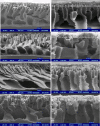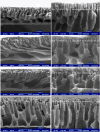Preparation and characterization of poly (ethersulfone) nanofiltration membranes for amoxicillin removal from contaminated water
- PMID: 24401148
- PMCID: PMC3901030
- DOI: 10.1186/2052-336X-12-18
Preparation and characterization of poly (ethersulfone) nanofiltration membranes for amoxicillin removal from contaminated water
Abstract
Nowadays, antibiotics such as amoxicillin have been entered in water bodies. Nanofiltration has been proposed as an attractive technology for removal of antibiotics from aquatic environment instead of conventional wastewater treatment. In this paper, novel asymmetric flat sheet nanofiltration membranes were prepared via immersion precipitation technique and by using the poly(ethersulfone)/Brij®S100/Poly(vinylpirrolidone)/1-methyl-2-pyrolidone casting solutions. The effect of addition of Brij®S100 as a non-ionic surfactant additive as well as concentration of poly (ethersulfone) on morphology, wettability, pure water flux and rejection of amoxicillin were studied using the scanning electron microscopy, water contact angle apparatus and experimental set-up. The results indicated that the addition of Brij®S100 to the casting solutions resulted in the formation of membranes with higher hydrophilicity and relatively noticeable rejection of amoxicillin up to 99% in comparison with unmodified poly(ethersulfone) membrane. Contrary to amoxicillin rejection, pure water flux was decreased when higher poly(ethersulfone) concentration was employed.
Figures








References
-
- Elmolla E, Chaudhuri M. Biodegradability improvement of antibiotics aqueous solution by fenton process. National postgraduate conference (NPC) Universiti Teknologi Petronas; 2009.
-
- Zazouli MA, Ulbrich M, Nasseri S, Susanto H. Effect of hydrophilic and hydrophobic organic matteron amoxicillin and cephalexin residuals rejection from water by nanofiltration. J Environ Health Sci Eng. 2010;7:15–24.
-
- Zhang W, He G, Gao P, Chen G. Development and characterization of composite nanofiltration membranes and their application in concentration of antibiotics. Sep Purif Technol. 2003;30:27–35. doi: 10.1016/S1383-5866(02)00095-3. - DOI
-
- Koyuncu I, Arikana OA, Wiesner MR, Rice C. Removal of hormones and antibiotics by nanofiltration membranes. J Membr Sci. 2008;309:94–101. doi: 10.1016/j.memsci.2007.10.010. - DOI
LinkOut - more resources
Full Text Sources
Other Literature Sources

